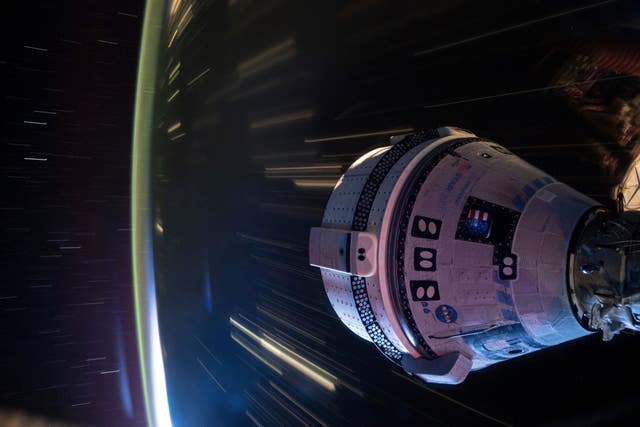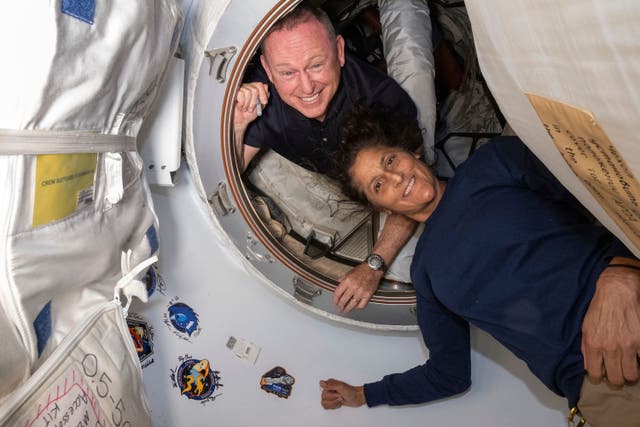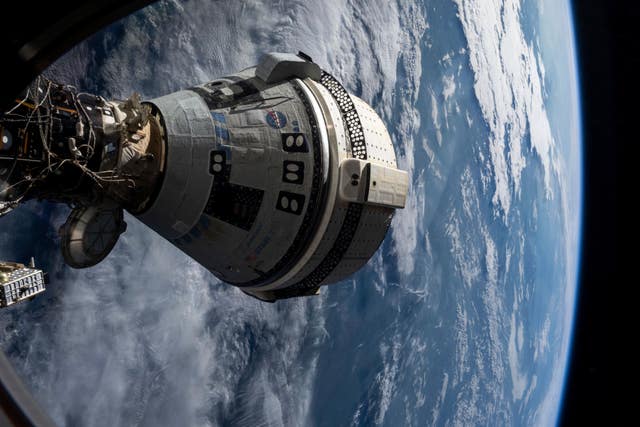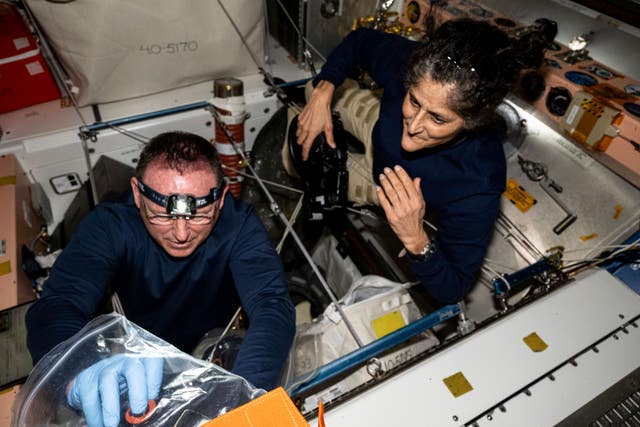Nasa has decided it is too risky to bring two astronauts back to Earth in Boeing’s troubled new capsule, and they will have to wait until next year for a ride home with SpaceX.
What should have been a week-long test flight for Butch Wilmore and Suni Williams will now last more than eight months.
The seasoned pilots have been stuck at the International Space Station since the beginning of June.

A cascade of vexing thruster failures and helium leaks in the new capsule marred their trip to the space station, and they ended up in a holding pattern as engineers conducted tests and debated what to do about the trip back.
After almost three months, the decision finally came down from Nasa’s highest ranks on Saturday.
Mr Wilmore and Ms Williams will come back in a SpaceX spacecraft in February.
Their empty Starliner capsule will undock in early September and attempt to return on autopilot and touch down in the New Mexico desert.
As Starliner’s test pilots, the pair should have overseen this critical last leg of the journey, with touchdown in the US desert.
“A test flight by nature is neither safe nor routine,” said Nasa administrator Bill Nelson.
“And so the decision … is a commitment to safety.”
“This has not been an easy decision, but it is absolutely the right one,” said Nasa associate administrator Jim Free.
It was a blow to Boeing, adding to the safety concerns plaguing the company on its aeroplane side.
Boeing had counted on Starliner’s first crew trip to revive the troubled programme after years of delays and ballooning costs.
The company had insisted Starliner was safe based on all the recent thruster tests both in space and on the ground.
Boeing did not participate in Saturday’s news conference by Nasa but released a statement saying: “Boeing continues to focus, first and foremost, on the safety of the crew and spacecraft.
“We are executing the mission as determined by Nasa, and we are preparing the spacecraft for a safe and successful uncrewed return.”
Retired navy captains with previous long-duration spaceflight experience, Mr Wilmore, 61, and Ms Williams, 58, anticipated surprises when they accepted the shakedown cruise of a new spacecraft, although not quite to this extent.

Before their June 5 launch from Cape Canaveral, Florida, they said their families bought into the uncertainty and stress of their professional careers decades ago.
During their lone orbital news conference last month, they said they had trust in the thruster testing being conducted.
They had no complaints, they added, and enjoyed pitching in with space station work.
Mr Wilmore’s wife, Deanna, was equally stoic in an interview earlier this month with WVLT-TV in Knoxville, Tennessee, their home state.
She was already bracing for a delay until next February, saying: “You just sort of have to roll with it.”
Nasa’s Norm Knight said he talked to the astronauts on Saturday and they fully support the decision to delay their return.
There were few options.
The SpaceX capsule currently parked at the space station is reserved for the four residents who have been there since March.
They will return in late September, their stay extended a month by the Starliner dilemma.
Nasa said it would be unsafe to squeeze two more into the capsule, except in an emergency.

The docked Russian Soyuz capsule is even tighter, capable of flying only three – two of them Russians wrapping up a year-long stint.
So Mr Wilmore and Ms Williams will wait for SpaceX’s next taxi flight.
It is due to launch in late September with two astronauts instead of the usual four for a routine six-month stay.
Nasa yanked two to make room for Mr Wilmore and Ms Williams on the return flight in late February.
Nasa said no serious consideration was given to asking SpaceX for a quick standalone rescue.
Last year, the Russian Space Agency had to rush up a replacement Soyuz capsule for three men whose original craft was damaged by space junk.
The switch pushed their mission beyond a year, a US space endurance record still held by Frank Rubio.
Starliner’s woes began long before its latest flight.

Bad software fouled the first test flight without a crew in 2019, prompting a do-over in 2022.
Then parachute and other issues cropped up, including a helium leak in the capsule’s propellant system that nixed a launch attempt in May.
The leak was eventually deemed to be isolated and small enough to pose no concern.
But more leaks sprouted following lift-off, and five thrusters also failed.
All but one of those small thrusters restarted in flight.
But engineers remain perplexed as to why some thruster seals appear to swell, obstructing the propellant lines, then revert to their normal size.
These 28 thrusters are vital.
Besides being needed for space station rendezvous, they keep the capsule pointed in the right direction at a flight’s end as bigger engines steer the craft out of orbit.
"NASA has decided that Butch and Suni will return with Crew-9 next February."@SenBillNelson and agency experts are discussing today's decision on NASA's Boeing Crew Flight Test. Watch live with us: https://t.co/M2ODFmLuTj pic.twitter.com/J2qvwOW4mU
— NASA (@NASA) August 24, 2024
Coming in crooked could result in catastrophe.
With the Columbia disaster still fresh in many minds – the shuttle broke apart during re-entry in 2003, killing all seven aboard – Nasa embraced open debate over Starliner’s return capability.
Dissenting views were stifled during Columbia’s doomed flight, just as they were during Challenger’s in 1986.
Despite Saturday’s decision, Nasa is not giving up on Boeing.
Nasa went into its commercial crew programme a decade ago wanting two competing US companies ferrying astronauts in the post-shuttle era.
Boeing won the bigger contract: more than four billion dollars (£3 billion), compared with SpaceX’s 2.6 billion dollars (£2 billion).
With station supply runs already under its belt, SpaceX aced its first of now nine astronaut flights in 2020, while Boeing got bogged down in design flaws that set the company back more than one billion dollars (£758 million).
Nasa officials still hold out hope that Starliner’s problems can be corrected in time for another crew flight in another year or so.




Comments: Our rules
We want our comments to be a lively and valuable part of our community - a place where readers can debate and engage with the most important local issues. The ability to comment on our stories is a privilege, not a right, however, and that privilege may be withdrawn if it is abused or misused.
Please report any comments that break our rules.
Read the rules hereLast Updated:
Report this comment Cancel